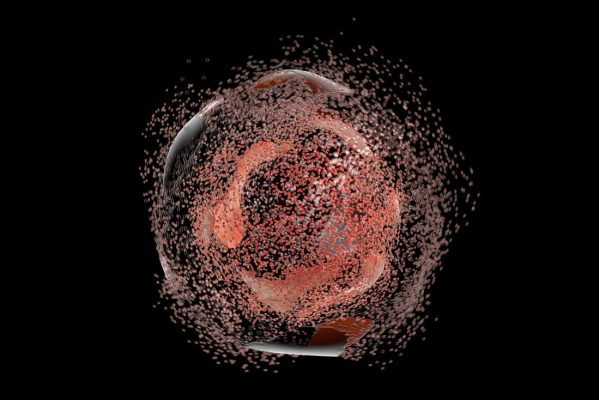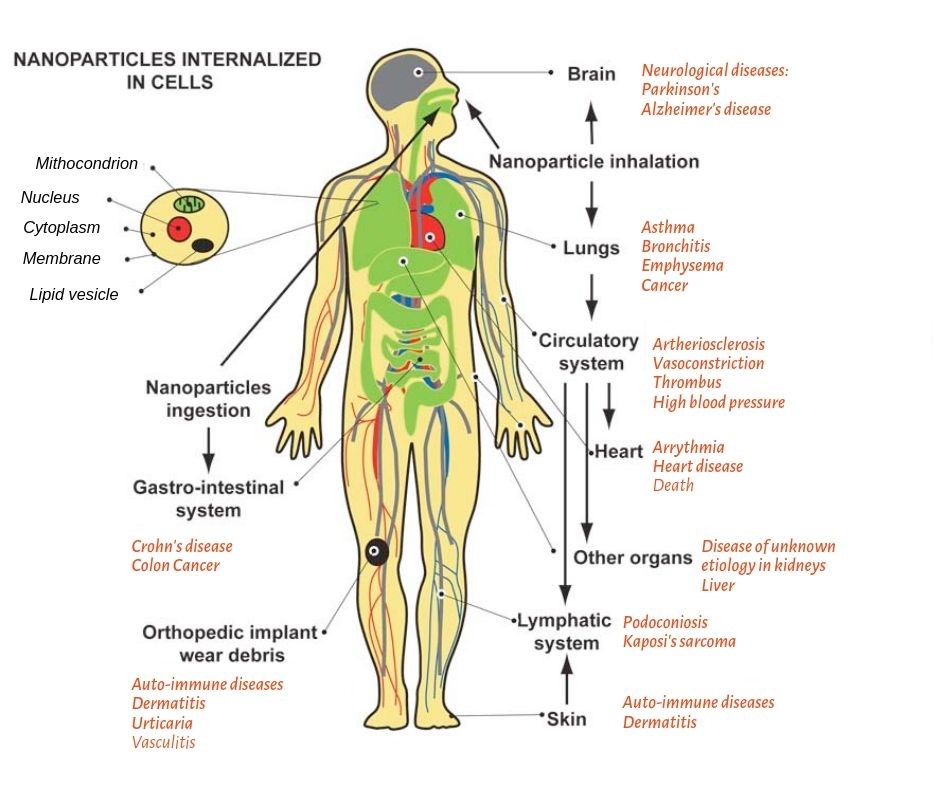Nanotoxicology refers to the study of nanomaterials and their toxicity. This is a huge field, but let’s provide a basic, what-you-need-to-know introduction.
There are thousands of different nanomaterials, some examples include:
- For drug delivery:
- Nanoshells (Gold, C60…)
- Dendrimers
- Polymers
- Liposomes (used in the injectable)
- Nano computing
- Quantam dots (made of cadmium, other metals or possibly carbon)
- Graphene
- Carbon nanotubes (nanobots)
- A few among thousands of others
- Silver for anti-bacterial properties
- Titanium dioxide (in cosmetics and skincare products)
- Nanocellulose in food packaging
- Many more will be covered in a future blog about everyday exposure to nano
Because of their size and other scientific properties allowing controlling shape, surface charge, pH and other elements nano particles can bypass any protective layer or barrier in the body
Nano particles can bypass any protective layer or barrier in the body
Nano particles can easily:
- cross the blood-brain barrier
- cross the gut-blood barrier
- cross the blood-testis barrier
- cross the placental barrier
- enter any cell, bypassing or damaging it’s protective membrane
- enter a cell’s nucleus where it’s genetic code is stored
Nano particles can enter your system throughout your regular day through inhalation (breath), skin absorption (touch) or ingestion (eat/drink).
Once in your system nanoparticles can enter your brain, organs, respiratory system, reproductive system, central and peripheral nervous systems and circulate through your blood.
Scientists have been warning about the dangers of these particles for the last 20 years, but the opportunity for commercial gain has far outweighed the caution regarding the danger for corporate giants.
On a mollecular and cell level, nano can do the following:
- Deprive a cell of oxygen causing oxidative stress and inflamation (Reactive Oxygen Species)
- Steal a cell’s proteins by binding to them (protein corona)
- Interfere with chemical signals between neurons (synapse function interference)
- Physically damage the cell or any of it’s components including the nuclei or mitochondria (the cell’s energy factory)
- Cause genetic mutations by damaging the genetic code
- Cause damage through other mechanisms such as metal toxicity, nano-induced platelet aggregation (causing blood clots) and even blocking the ion channels inside cells
So what does this damage mean in a practical sense?
Nano toxicity often represents itself in low level chronic issues.
Do you have a chronic issue which you have tried multiple remedies for?
Did those remedies work for a short period, before the ailment came back?
That’s nano toxicity
Do you have chronic issues that come and go regularly, as if on a schedule? For days or weeks at a time.
That’s nano toxicity.
Do you have skin rashes or other skin issues?
Nano of a certain size accumulates in follicular openings, sebaceous glands and skin folds, causing damage.
Do you know anyone who has toe fungus? And natural, ‘tried & true’ remedies don’t work anymore?
Nano metals that are detected by the immune system are pushed away from the vital organs, to the feet. The metal nano aggregates causing metal toxicity, which the body responds to by growing a fungus.
Do you have low energy? Brain fog?
Nano can attack the energy factory in your cells, making it harder to produce energy. Nano can also aggregate in certain brain centers, causing brain fog and reducing the ability to focus.
Hair loss? Or hair that becomes shrivelled or feels weird?
Nanoparticles often bind to hair at a small scale and can cause the hair to die or take on a strange shrivelled or plastic-like quality.
Do you know anyone with a neuro-degenerative disease such as MS?
Nanoparticles have been found to directly alter the structure and function of the neural system.
The cause of MS is the synapse signals between neurons becoming weak. Nanoparticles can cause this through interfering with those synapse signals.
Are you sensitive to high electro-magnetic field areas, such as shopping centres?
Nanoparticles often have magnetic and conductive properties that utilise, magnify or respond to these signals. More will be covered in a future blog on weaponized nano and self-assembly.
Weight issues?
Nanoparticles can create a synthetic lining of your stomach, reducing nutrient absorption. Literally making you eat more.
Here’s a diagram by the Canadian Government, that sums it up well:
So there you have it, a basic introduction to nano-toxicology. Good work on being one of the few that got this far.
I know this all sound pretty scary, and you should be scared.
But not too much. There is no dark without light. And no problem, without a solution.
What solution are you using to protect your health?
References
Lecture 1: Introduction to nanotoxicology (lecture begins at 15-minute time-stamp)
Lecture 2: Synthesis of nanoparticles from nanotoxicology perspective
Lecture 3: Functionalization of nanoparticles
Lecture 4: Nanotoxicity on cellular level
Lecture 5: Nanotoxicity on organism level
Lecture 6: In vitro toxicity evaluation
Lecture 7: Cytotoxicity evaluation
Lecture 8: Particular problems of nanotoxicology
Impact of Nano-particles on Brain Health
Nanoparticle-induced platelet aggregation and vascular thrombosis
2D MoS2 and BN Nanosheets Damage Mitochondria through Membrane Penetration
Single-walled Carbon Nanotubes Are a New Class of Ion Channel Blockers


